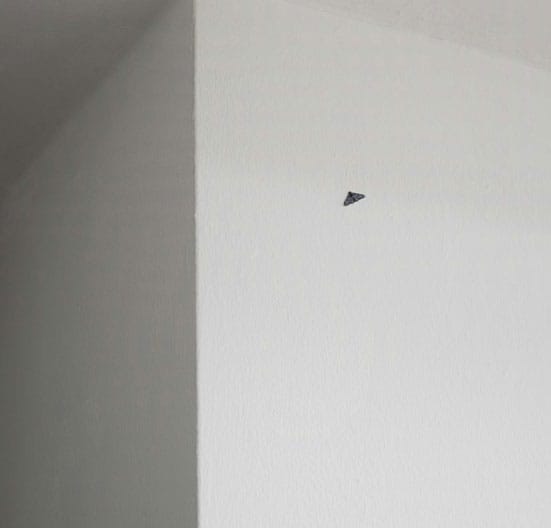17th July 2007 — 1st September 2007
In
1953 Robert Rauschenberg erased a drawing by Willem de Kooning, framed
the remaining piece of paper, and claimed it as his own work. The task
wasn't easy; de Kooning had used thick layers of chinagraph pencil,
ink, graphite and wax crayon. It took Rauschenberg a month to 'clean'
the paper.
Strikingly, 'Erased de Kooning' successfully appropriates the iconicity
of de Kooning's work, only to answer that masculine expressivity with a
terminal gesture of iconoclasm: erasure. This act predates the official
epoch of Conceptual Art by at least fifteen years, yet employs several
intrinsically Conceptual tenets: aesthetic economy; a narrative process
of explication; a subsequent emphasis on mental agency; and awareness
of significant shared cultural memory. De Kooning epitomises the
potency, both gendered and aesthetic, of abstract expressionism and
American art at the time. His works sold for substantial sums, and the
respect he garnered was universal. And although de Kooning said he
would very much miss the drawing, Rauschenburg's act was not as
derisive as immediately conjectured. The cultural prestige of de
Kooning is of paramount importance to the success of the piece; his
domineering aura saturates the work, if only in conception. The idea of
the work is preserved and amplified within the form, and so becoming
the mettle of the piece.
'Invisible' - a fairly typical summer group-show - at Max Wigram,
presents several artists whose work conducts a similar dialogue to
Rauschenberg's 'Erased de Kooning'. Paul Pfeiffer's 'Four Horsemen of
The Apocalypse' is a vast, colour photograph of Marilyn Monroe, in
which the star herself has been deleted, leaving only her shadow. 'Good
Vibrations' by Damien Roach is the eponymous song by The Beach Boys
lowered so much in pitch as to be inaudible; the physical pulse of the
speaker's subwoofer the only evidence of the performance. The
familiarity in these two appropriated cultural products lies
predominantly with the element the artist has removed. By eliminating
Marilyn Monroe's 'look', we are compelled to imagine and perhaps
amplify the reality; and with 'Good Vibrations', the effect of knowing
that it's playing, but not being able to hear it, is as good as playing
it unbearably loud. The absent and present are equally redolent of
their subject.
Michael Ashcroft's 'Other People's Achievements' is a series of framed
images from exotic travel supplements, each with the human achievers in
the landscape painted over with oils so as to completely camouflage
them. It's a strikingly morbid act, particularly because of the
subjects' anonymity. There is something uniquely unsettling about the
deletion of the nameless: only ever having existed in their absence,
when they are gone, no memory rushes in to take their place. This is
appropriation 'in absentia', where an artist sequesters cultural memory
that is itself concerned with its own pastiche. Gianni Motti's 'Magic
Ink' - five drawings in invisible ink - headily combine Rauschenberg's
antonymic creative erasure with a hermetic alchemy: these drawings are
still there, doomed to exist in perpetual absence, their 'true' form
hidden forever. Of course, invisibility may have its own invisible
agenda. The peppered moth, as depicted in Damien Roach's piece, evolved
its 'peppered' look to be able to camouflage itself against its newly
industrialised habitat in Victorian England. Its original morphology
was entirely white, a more suitable disguise against the pristine white
walls of a modern art gallery.
Ironically, there were several pieces that were not visible at all.
Pierre Bismuth apparently had three 'Black Paintings' in the show,
although I could only find one. Cory Arcangel, prominently listed as
exhibiting, was not in evidence at all. When I asked, rather
embarrassed, if the invigilator might point out the missing pieces, he
politely told me that they were not, and never had been, a part of the
exhibition. I'd like to believe that this was an intentional curatorial
conceit: that, albeit within a tighter arrangement of shared cultural
memory, Max Wigram and Co. had exhibited several truly invisible works
of art, which were conjured only in suggestion on the press release.
However, this conceptual trope is surely, really, not there.
Ultimately, as an 'Invisible' show probably should, the ambiguity
implicit in the title is made manifest in the absence of curatorial
enterprise. The pieces are also somewhat monothematic in their
engagement regarding ideas of visibility, and there are too many
hermetic processes, as looped and complete as zeros. Perfection, I
suppose, is analogous to invisibility.
When describing the way he felt about 'Erased de Kooning',
Rauschenberg commented "... in the end it really worked. I liked the
result. I felt it was a legitimate work of art, created by the
technique of erasing. It was poetry." Erasing as appropriation is
inevitably a poetic, rather than an empirical gesture. It is bound
wonderfully in an affirmation of the primacy of the self and one's own
imaginative faculties.
EA
Max Wigram Gallery
99 New Bond Street
London W1S 1SW
http://www.maxwigramgallery.com/
Open
Tuesday-Friday, 10am-6pm
Saturday, 1pm-5pm
